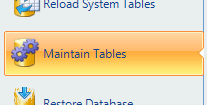As a database matures and records are added and deleted, they eventually need a little bit of maintenance. When you log in as the administrator user you can run various table maintenance functions to keep your database running smoothly.
Note: A database preference controls how often the system will prompt you to maintain tables. Depending on usage, frequency of deletes, etc., maintenance should be performed every 30-90 days.
Maintaining Tables
1.Open the Database Toolkit
2.Choose Maintain Tables.


3.The following fields are available:
•Database Profile - Lists the database profiles found on the computer. Note that for this tool, the server database itself is also available for selection (listed as "<Local Database Server>"). Sometimes a computer crash can leave the server database in a bad state, so this lets you repair it.
•Action -
oCheck Tables - checks each table for errors and indicates any problems in the output generated
oCheck and Repair Tables - same as Check Tables, but also automatically attempts the repair of any table indicating a problem
oOptimize Tables - this should be used monthly, or if you have deleted a large number of records. Ordinarily, running an optimization once a month will keep tables compacted and well optimized. The most common use of the Optimize function is to reclaim allocated but unused space in a table (such as when a large block of records has been deleted.) This is a little like optimizing a computer's hard disk.
oRun Support Script - see Running a Support Script for details.
4.Click Start to start the selected action.
5.When the processes finishes, a list of output messages will be displayed. A given table may be shown more than once; the first entry may show an error, followed by another entry showing "OK", meaning the problem was corrected. The last row shown for any table should always have a Message Text entry of "OK" or "Table is already up to date." If you see any other message, run the "Check & Repair Tables" action.
Maintenance Frequency
It is a good idea to get in the habit of running the table maintenance operations on a monthly to quarterly basis, depending upon how much activity you have on your database (i.e., a database with 10 concurrent users and a half-million records will require more frequent maintenance for optimal performance) than a single-user database with 500 records. Think of table maintenance as basic housekeeping for a healthy database. Like changing the oil in your automobile, it keeps the database engine running well.
At a minimum, run Check Tables and look at the results. If any errors or warnings are reported, run the Check & Repair Tables option and then run Check Tables again. When finished, run Optimize Tables to refresh indexes and compact and organize your data.